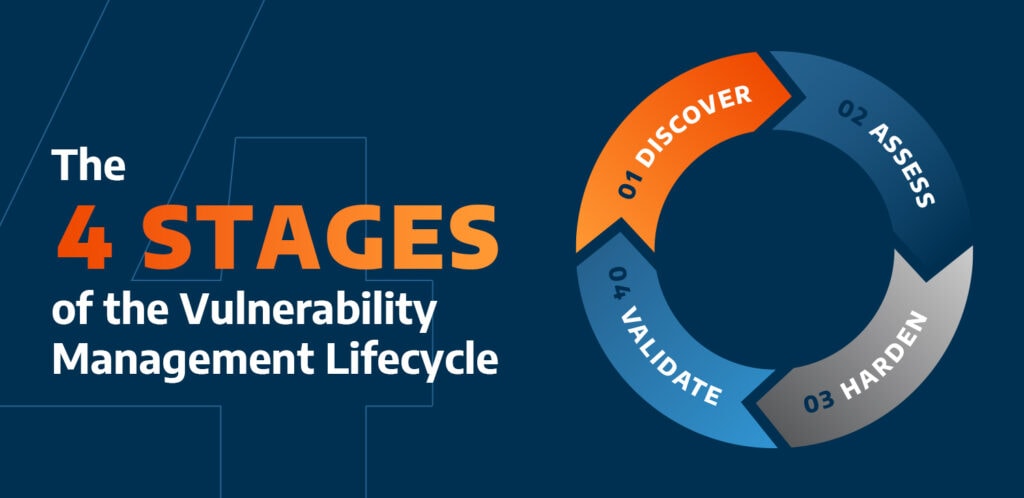What Is Vulnerability Management?
Vulnerability management is the ongoing process of identifying, assessing, and remediating vulnerabilities within your network or systems.
The four stages of the vulnerability management lifecycle are:
- Discover
- Assess
- Harden
- Validate
Vulnerability management may be a linear process for a single vulnerability, but within the context of your proactive cybersecurity framework, it is a cycle where multiple stages can be happening simultaneously.
Vulnerabilities and Vulnerability Classification
To understand vulnerability management, you must first understand vulnerabilities. A vulnerability is a weakness that exists within a software program that allows cybercriminals to gain access, complete tasks, or use the weakness in combination with malware and other tools to launch a cyber attack.
As the cloud becomes more commonplace, cloud vulnerabilities are also increasing, often referred to as “misconfigurations.” There are tens of thousands of existing vulnerabilities — 2022 saw over 25,000 recorded vulnerabilities, with over 800 actively exploited by threat actors. As software grows in volume, so does the number of vulnerabilities.
Vulnerabilities fall into four main categories — network, operating system, process, and human — and are classified based on how severe of a threat they could pose to an organization. It’s important to note that just because a vulnerability is classified as critical does not mean it is a high-risk for your organization. Vulnerability management depends on internal business and security risks, not just outside expertise.

What Is Risk-Based Vulnerability Management?
Because every organization has different security and business needs that can change, the goal with vulnerability management should not be to eliminate every possible vulnerability, but to take a risk-based approach that reduces risk over time.
One way to do that is to look for the five riskiest kinds of vulnerabilities that can appear. They are:
- Remote Code Execution
- Hardcoded Credentials
- Denial of Service
- Directory Traversal
- Privilege Escalation
All five of these vulnerabilities can be leveraged together at different stages of an incident to further the attack and lead to a full-fledged breach.
At each of the four vulnerability management lifecycle stages listed above, your organization is making security decisions and deciding on actions, and often that means deciding on how much risk to accept. The reality is you can’t patch every vulnerability that appears. However, having a regular patching process in place and proactively working on vulnerability management can make a major difference in your cybersecurity architecture, reducing the risk of a breach.
Vulnerability Remediation and Patching
Patching is a form of vulnerability management, specifically vulnerability remediation, where an individual vulnerability’s risk is remediated.
It’s important to note that vulnerability remediation and vulnerability mitigation are different. Remediation is where the vulnerability can be taken care of. If there is no patch available, and your organization has to create a workaround, that is mitigation. Both are components of a vulnerability management program.
Vulnerability Management v. Vulnerability Assessment
Just like with remediation, vulnerability assessment is just one part of an overall vulnerability management program. Assessment falls into the “risk-based” category, where your organization looks at the individual vulnerability and determines what steps, from a business and security perspective, need to be taken next. Because it’s impossible to patch every vulnerability, sometimes that action is to “do nothing.”
The Importance of Vulnerability Management
Vulnerability management plays a critical role in what is called proactive cybersecurity. That is the side of cybersecurity that deals with reducing and mitigating potential risks before they become incidents or breaches. Vulnerability management is not just a box to check, but a critical piece of an overall strategy aimed at reducing risk and eliminating threats.
In addition, vulnerabilities are a major cause of breaches. In the first half of 2022 alone, 81% of incidents happened through an external exposure — either a known vulnerability or a remote desktop protocol. Out of the five most exploited vulnerabilities in 2022, four had been known since 2021, highlighting how patching can literally save the day. While zero-day exploits make headlines (and for good reason), it’s the more mundane, known vulnerabilities that cause the most problems.
Threat intelligence, while its own pillar of proactive cybersecurity, can also play a key role in vulnerability management, helping organizations understand what vulnerabilities exist and the risk they play within the organization’s environment.
Vulnerability Management and Arctic Wolf
Achieving strong vulnerability management alone is no easy task. Whether it’s through a shortage of skills, personnel, or time, too many organizations are in a place where vulnerability management falls by the wayside. They’re stuck in a cycle of reacting to immediate threats, and are unable to take proactive measures to harden their environment. A partnership with a security operations solutions provider helps solve this issue while providing support, expertise, and hands-on-keyboards.
Arctic Wolf® Managed Risk enables you to discover, assess, and harden your environment against digital risks by contextualizing your attack surface coverage across your networks, endpoints, and cloud environments.
Arctic Wolf® Cloud Security Posture Management security operations identify cloud resources at risk and provide guidance on hardening their posture.


